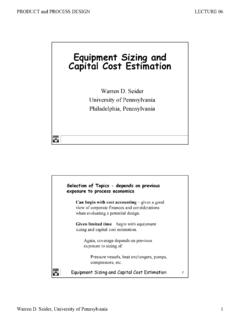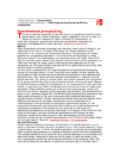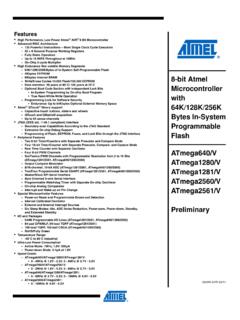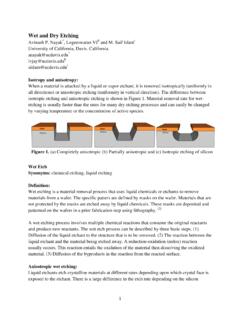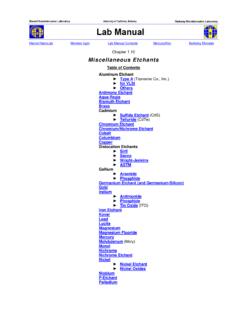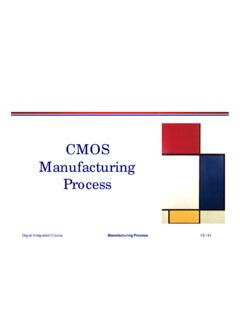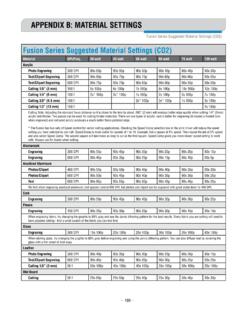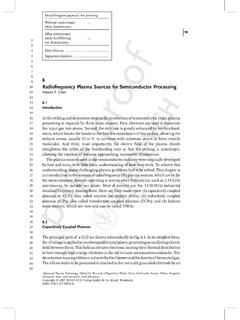Transcription of Etch rates for micromachining processing-part II ...
1 Personal use of this material is permitted. However, permission to reprint/republish this material for advertising or promotional purposes or for creating new collective works for resale or redistribution to servers or lists, or to reuse any copyrighted component of this work in other works must be obtained from the IEEE. This material is JOURNAL. presented OF. to ensure timely dissemination of scholarly MICROELECTROMECHANICAL SYSTEMS, and technical VOL. 12, Copyright2003. 6, DECEMBER and all rights therein are retained by authors or by other copyright holders. 761 All persons copying this information are expected to adhere to the terms and constraints invoked by each author's copyright. In most cases, these works may not be reposted without the explicit permission of the copyright holder. etch rates for micromachining processing Part II. Kirt R. Williams, Senior Member, IEEE, Kishan Gupta, Student Member, IEEE, and Matthew Wasilik Abstract Samples of 53 materials that are used or potentially be used in future fabrication of microelectromechanical systems can be used or in the fabrication of microelectromechanical (MEMS) and integrated circuits (ICs) (approximately 50 etch systems and integrated circuits were prepared: single-crystal rates measured in the earlier paper have been included in this silicon with two doping levels, polycrystalline silicon with two doping levels, polycrystalline germanium, polycrystalline SiGe, one).
2 These data allow the selection of new combinations of graphite, fused quartz, Pyrex 7740, nine other preparations of structural material, underlying material, and etchant for micro- silicon dioxide, four preparations of silicon nitride, sapphire, machining. two preparations of aluminum oxide, aluminum, Al/2%Si, tita- Table I summarizes the etches tested, abbreviated names for nium, vanadium, niobium, two preparations of tantalum, two the etches, and the target materials for each. Table II lists etch preparations of chromium, Cr on Au, molybdenum, tungsten, nickel, palladium, platinum, copper, silver, gold, 10 Ti/90 W, 80. rates of Si,Ge, SiGe, and C in the SI units of nm/min (not /min Ni/20 Cr, TiN, four types of photoresist, resist pen, Parylene-C, as in the earlier tables) [3]. Table III covers films and wafers that and spin-on polyimide. Selected samples were etched in 35 are primarily silicon dioxide, produced under many different different etches: isotropic silicon etchant, potassium hydroxide, conditions.
3 Table IV is on silicon nitride and aluminum oxide. 10:1 HF, 5:1 BHF, Pad Etch 4, hot phosphoric acid, Aluminum Table V covers the metals Al, Ti, V, Nb, Ta, and Cr. Table VI. Etchant Type A, titanium wet etchant, CR-7 chromium etchant, continues with the metals Mo, W, Ni, Pd, Pt, Cu, Ag, Au, alloys CR-14 chromium etchant, molybdenum etchant, warm hydrogen peroxide, Copper Etchant Type CE-200, Copper Etchant APS 10 Ti/90 W, 80 Ni/20 Cr, and compound TiN. Finally, Table VII. 100, dilute aqua regia, AU-5 gold etchant, Nichrome Etchant gives etch rates of organics: photoresists, a resist pen, and a TFN, hot sulfuric phosphoric acids, Piranha, Microstrip 2001, spin-on polyimide. acetone, methanol, isopropanol, xenon difluoride, HF H O Section II of this paper lists the materials etched, their prepa- vapor, oxygen plasma, two deep reactive ion etch recipes with two ration, and some uses or potential uses in MEMS and ICs. Sec- different types of wafer clamping, SF plasma, SF O plasma, CF plasma, CF O plasma, and argon ion milling.
4 The etch tion III describes the preparation and applications of the wet and rates of 620 combinations of these were measured. The etch rates dry etches that were studied, as well as some key experimental of thermal oxide in different dilutions of HF and BHF are also results. Section IV describes etch-rate measurement techniques, reported. Sample preparation and information about the etches is and Section V discusses the results. given. [1070]. Index Terms Chemical vapor deposition (CVD), etching, evap- II. SAMPLE PREPARATION. oration, fabrication, materials processing , micromachining . The preparation of the samples in the etch-rate tables is de- scribed below, listed by the labels (in italics) used across the tops I. INTRODUCTION of the tables. All coated materials were deposited on 100-mm- HEN designing a microfabrication process, the etch rate diameter silicon wafers. For the isotropic silicon etchant, potas- W of each material to be etched must be known.
5 Knowing the etch rates of other materials that will be exposed to the etch, sium hydroxide, and a few other etches, the wafers were first coated with LPCVD silicon nitride so that etches would not pen- such as masking films and underlying layers, enables an etch etrate into the silicon or attack the back side of the wafer. process to be chosen for good selectivity (high ratio of etch In several cases, similar materials were prepared using dif- rate of the target material to etch rate of the other material) if ferent methods ( , wafer form, PECVD, LPCVD, and ion- one exists. While several large literature-review compilations milled silicon dioxide; annealed and unannealed films) to study of etches that target specific materials have been made [1], [2], and emphasize the effect on their etching characteristics. these only report etch rates in some cases, and rarely have corre- Existing or potential MEMS applications are given for the sponding selectivity information.
6 This paper provides such in- materials. Many of the materials were discussed in more detail formation, expanding on an earlier paper [3] to give 620 etch previously [3]. rates of 53 materials in 35 etches that have been used or may A. Silicon, Germanium, SiGe, and Carbon (100) Si Low-Doped Wafer: Single-crystal silicon, (100) ori- Manuscript received June 3, 2003; revised October 1, 2003. Subject Editor A. J. Ricco. entation, phosphorus-doped n-type, resistivity of 3 40 -cm, K. R. Williams was with Agilent Laboratories, Agilent Technologies, Palo grown with the Czochralski (CZ method). Single-crystal silicon Alto, 94303 CA USA. He is currently a private consultant at 185 Willowbrook is the standard starting material for bulk micromachining . Dr., Portola Valley, CA 94028 USA (e-mail: K. Gupta was with with Agilent Laboratories, Agilent Technologies, Palo Float-Zone Si Wafer: Single-crystal silicon, (100) orienta- Alto, CA 94303 USA.)
7 He is now at 804 Gregory Ct., Fremont, CA 94359 USA tion, undoped, grown with the float-zone (FZ) method for a high (e-mail: resistivity of -cm. Float-zone wafers have been used M. Wasilik is with the Berkeley Sensor & Actuator Center, University of Cal- ifornia at Berkeley, Berkeley, CA 94720-1770 USA. as substrates in RF MEMS application to reduce eddy-current Digital Object Identifier loss. 1057-7157/03$ 2003 IEEE. 762 JOURNAL OF MICROELECTROMECHANICAL SYSTEMS, VOL. 12, NO. 6, DECEMBER 2003. TABLE I. ETCH DESCRIPTIONS, ABBREVIATIONS, AND TARGET MATERIALS. Polysilicon LPCVD Undoped: Undoped polycrystalline sil- Polysilicon LPCVD In-Situ : An n-type, phosphorus- icon deposited in a Tylan low-pressure chemical-vapor deposi- doped polycrystalline silicon deposited in a Tylan LPCVD. tion (LPCVD) furnace with recipe SiH sccm, furnace with recipe sccm, PH /balance temperature , pressure mtorr. sccm, , mtorr. Deposited Deposited on a wafer with 100 nm of thermal oxide on a wafer with thermal oxide on it to enable interferometric on it to enable interferometric thickness measurements.)
8 Thickness measurements.. In situ doping gives a . Undoped poly, which has conducting film, useful for thicker films and in cases in which a high sheet resistance as deposited, is the most common other considerations limit the temperature. The deposition rate is structural material for surface micromachining . It can be doped about that of undoped polysilicon under similar conditions. with ion implantation or by diffusing in dopant atoms from an Poly Ge LPCVD Undoped: Undoped polycrystalline germa- adjacent film ( , PSG, below) at high temperature. nium deposited in Tystar LPCVD furnace with recipe WILLIAMS et al.: etch rates for micromachining processing PART II 763. TABLE II. ETCH rates OF Si, Ge, SiGe, AND C (nm/min). sccm, , mtorr. The polygermanium Polygermanium has been used in surface micromachining as deposition was preceded by the deposition of silicon seed layer a sacrificial layer in conjunction with a polycrystalline SiGe approximately 6 nm thick using the recipe sccm, structural layer, using warm hydrogen peroxide as the etchant , mtorr.
9 [4]. The relatively low deposition temperatures are compatible Germanium forms an oxide that is soluble in water. Thus, with CMOS circuitry with aluminum interconnections. water with a high concentration of dissolved oxygen etches ger- Poly SiGe LPCVD -Type: A p-type polycrystalline silicon- manium. Hydrogen peroxide is a useful etchant for Ge, etching germanium deposited in a Tystar LPCVD furnace with recipe faster at higher temperature. sccm, sccm, sccm, 764 JOURNAL OF MICROELECTROMECHANICAL SYSTEMS, VOL. 12, NO. 6, DECEMBER 2003. TABLE III. ETCH rates OF SILICON DIOXIDE (nm/min). , mtorr. This film is approximately 48 atomic B. Silicon Dioxide % Ge. Graphite Ion-Milled: Graphite ion-mill-deposited (also Fused Quartz Wafer: Wafers of General Electric 124 or known as ion-beam-deposited) in a Commonwealth Scientific NSG N fused quartz source material, % silicon dioxide, system from a graphite target with argon ions at 1250 V, with amorphous structure (as opposed to true crystalline current density of about 2 mA/cm ( mA over most of a quartz).)
10 This material is commonly referred to simply as 5-inch-diameter target), chamber torr. Graphite quartz. It is compatible with silicon-wafer processing steps, has had little or no use in MEMS to date. In this work, it was and may find application as a substrate in RF MEMS as it is found to be easily deposited and etched in silicon isotropic not conductive, eliminating eddy-current losses. etchant. It may find use as a hard mask for plasma etching due Pyrex 7740 Wafer: Corning Pyrex 7740 glass, 81% SiO , to its low etch rate, and as a dry lubricant in MEMS. 13% B O , 4% Na O, 2% Al O . Pyrex 7740 (and the very WILLIAMS et al.: etch rates for micromachining processing PART II 765. TABLE IV. ETCH rates OF SILICON NITRIDE AND ALUMINUM OXIDE (nm/min). similar Borofloat glass) are used in anodic bonding to silicon gas at 200 sccm, H O vapor at a pressure just below 1 atm (the due to the high content of mobile sodium ions and to the good water source is at 98 ) at 1100 , and a total pressure of 1.
